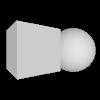ambient_light()#
Adds an ambient light.
Examples#

def setup():
py5.size(100, 100, py5.P3D)
py5.background(0)
py5.no_stroke()
# the spheres are white by default so
# the ambient light changes their color
py5.ambient_light(51, 102, 126)
py5.translate(20, 50, 0)
py5.sphere(30)
py5.translate(60, 0, 0)
py5.sphere(30)

def setup():
py5.size(100, 100, py5.P3D)
py5.background(0)
py5.no_stroke()
py5.directional_light(126, 126, 126, 0, 0, -1)
py5.ambient_light(102, 102, 102)
py5.translate(32, 50, 0)
py5.rotate_y(py5.PI/5)
py5.box(40)
py5.translate(60, 0, 0)
py5.sphere(30)
Description#
Adds an ambient light. Ambient light doesn’t come from a specific direction, the rays of light have bounced around so much that objects are evenly lit from all sides. Ambient lights are almost always used in combination with other types of lights. Lights need to be included in the draw() to remain persistent in a looping program. Placing them in the setup() of a looping program will cause them to only have an effect the first time through the loop. The v1, v2, and v3 parameters are interpreted as either RGB or HSB values, depending on the current color mode.
Underlying Processing method: ambientLight
Signatures#
ambient_light(
v1: float, # red or hue value (depending on current color mode)
v2: float, # green or saturation value (depending on current color mode)
v3: float, # blue or brightness value (depending on current color mode)
/,
) -> None
ambient_light(
v1: float, # red or hue value (depending on current color mode)
v2: float, # green or saturation value (depending on current color mode)
v3: float, # blue or brightness value (depending on current color mode)
x: float, # x-coordinate of the light
y: float, # y-coordinate of the light
z: float, # z-coordinate of the light
/,
) -> None
Updated on March 06, 2023 02:49:26am UTC
